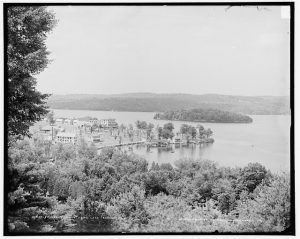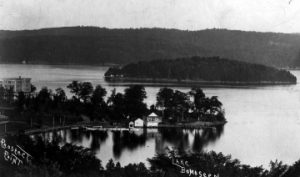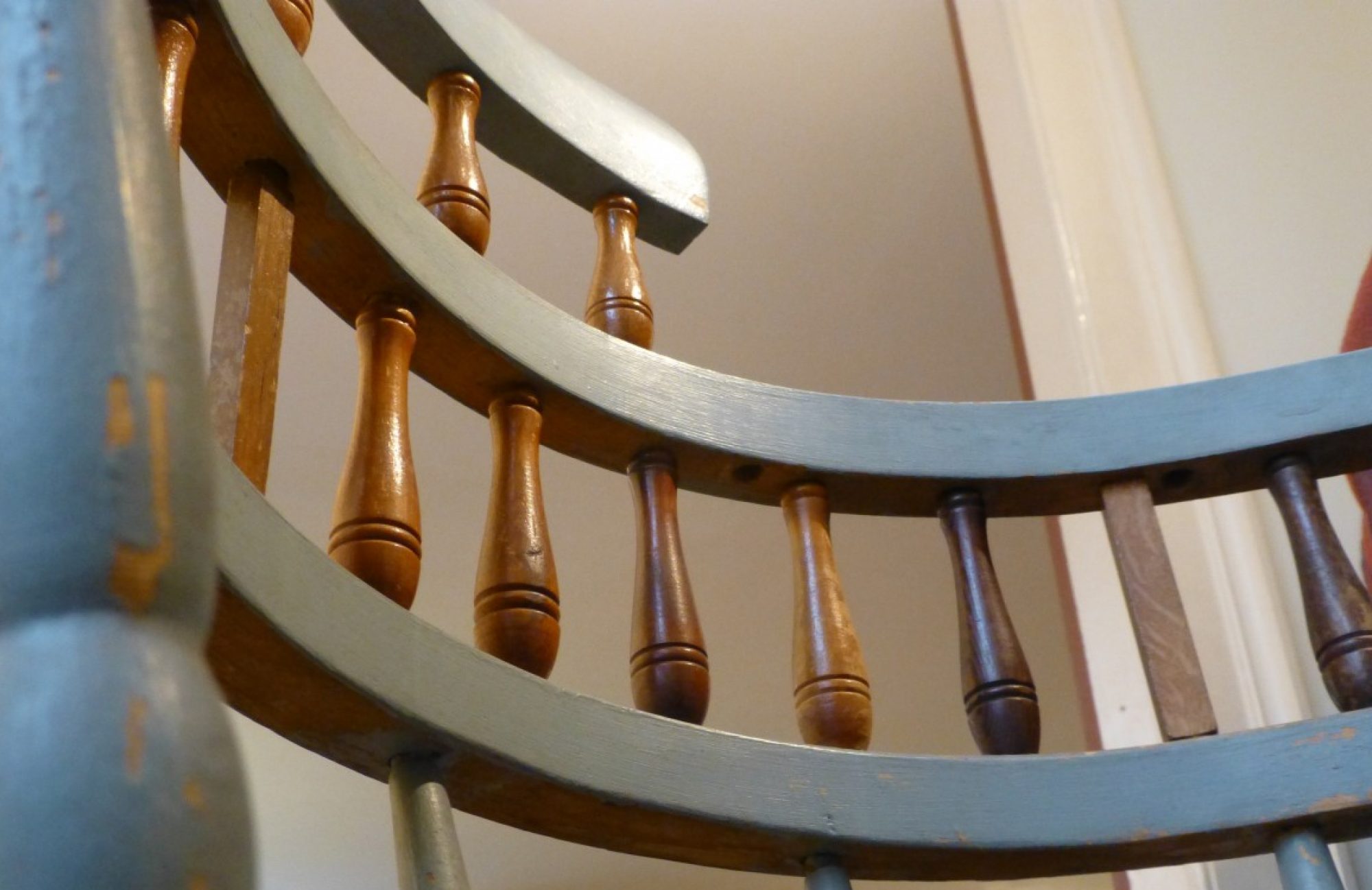
The 19th spindle on Henry Sheldon’s relic chair, a sample of white birch taken from Neshobe Island (Lake Bomoseen, Castleton, Vermont), was sent to Sheldon by John M. Currier of Castleton on July 2nd, 1884.(1) With the birch sample, Currier included a letter, in which he notes himself as the “originator” of the wood, but not the “author” and states that he prefers to keep that author’s identity a secret. This elusiveness is not unusual given Neshobe Island’s almost mythical propensity to be the site of secret societies and other organizations, to be discussed below. Furthermore, in this letter, Currier noted that his intention, in donating this relic, was to “establish the name of Neshobe on the island.” Neshobe was known by many different names until July 4th 1881, when the Rutland Historical Society staged a celebration on Lake Bomoseen’s banks attended by over ten thousand people. The island was named after a Native American man who, during the Civil War, informed Union soldiers of enemy movements.(2) The island was christened “Neshobe Island” by breaking a bottle of milk on a rock.(3) This practice may have been intended to imitate the breaking of champagne to christen a new ship, but with a twist to honor Vermont’s dairy farms.

From John Currier’s earlier correspondences with Henry Sheldon, we can uncover a detailed history of the wood itself. According to Currier, on July 20th 1882, about a year after the naming of Neshobe, the Rutland County Historical Society had a picnic on the shores of Lake Bomoseen for which they formed a committee tasked with building a tripod, the purpose of which was to hold a kettle of coffee, from three Castleton sites. One leg of the tripod was from Mason’s Point (where the picnic was held), another from Neshobe Island, and a third from the site of the old Castleton military fort.(4) After this picnic, the tripod was broken apart, and Currier saved the white birch from Neshobe as well as maple wood from the Fort, presumably in the tradition of relic keeping, as he found both Neshobe and the Fort to be of historical significance.(4) It is worth mentioning that, while Neshobe Island is referenced before the historic ten-thousand-person gathering and christening in 1881, it does not seem to have been a significant landmark. There was a steamboat, the Naomi, that ferried passengers to and from the island from 1877 to 1889, but it is safe to assume that it was the 1881 gathering in-itself that brought Neshobe its historical significance.*
In order to better understand John Currier’s assignment of historical values to the white birch from Neshobe Island, it is important to understand the man himself. In a publication from 1903 that compiled the biographies of hundreds of Vermonters, Currier, who was born in 1836 in North Troy, Vermont, is described as the “embodiment of a sturdy New England race, bred and matured in the healthful wholesome, bracing atmosphere of the same state in which he was born”.(5) While most of this biography details his military career and political accomplishments, it also makes note of his “engrainment” in the lumber business, which had reached great proportions since he had entered it in 1871. It is likely that Currier’s involvement in the lumber business, managing a mill with the capacity to produce over 100 barrels a day led to an appreciation of wood associated with historical events and places, which explains his decision to hold onto the white birch from Neshobe and maple from the old Castleton Fort.(5)

While Neshobe Island may not have been historically significant before the ten-thousand-person gathering on the day it was officially named in July of 1881, it did gain national notoriety over forty years later as the summer home of Alexander Woollcott, a member of the mysterious Algonquin Round Table’s. Woollcott purchased the seven-acre island in 1924 and erected a small house on the land.(6) The island became well known over the following decades for its exclusive parties and eccentric guests, including Vivien Leigh, Harpo Marx, and Ben Hecht, who often walked around the grounds naked. Woollcott would yell “new man on island” when outsiders were in view of the beach, to alert his guests to be clothed, while other times he would strip naked, cake his body in mud, and place a red wig on his head as he ran out of the woods screaming and chanting.(7)
Woollcott remained the owner of Neshobe Island until his death in 1943, and the island remained uninhabited until 1999 at which point it was sold to Jerry Brown of Argyle, New York. Since then, the Brown family has completed restorations on Woollcott’s house, and the island remained in their ownership as of 2009.(8)
-Noah Fine ’20
*An account of the gathering on Mason’s Point compiled by John Currier himself is available online: https://archive.org/details/accountofcelebra1881curr
Footnotes:
1. Letter from John M. Currier to Henry Sheldon with wood from Neshobe Island, 2 July 1884. Collections of Henry Sheldon Museum of Vermont History, Middlebury, Vermont.
2. John Currier, An Account of the Celebration of the Fourth of July, 1881, at Mason’s Point, Lake Bomoseen (Rutland County Historical Society, 1881), 42. Also available online: https://archive.org/details/accountofcelebra1881curr
3. Esther M. Swift, Vermont Place-Names: Footprints of History, 1977 (Camden, ME: Picton Press, 1996), 385. For more on this tradition, see “Who, what, why: Why is champagne traditional for smashing on ships?” BBC News. July 04, 2014. Accessed February 02, 2018. http://www.bbc.com/news/magazine-28158790.
4. Letter sent from John M. Currier to Henry Sheldon, 31 March 1884. Collections of Henry Sheldon Museum of Vermont History, Middlebury, Vermont. See also Proceedings of the Rutland County Historical Society, vol. 2 (1882-1887); this “tripod” is discussed on pages 33 and 38: https://archive.org/stream/proceedingsofrutv2rutl#page/n61/
5. Hiram Carleton, Genealogical and Family History of the State of Vermont (New York: The Lewis Publishing Company, 1903), vol. 2, 514.
6. Leslie Landrigan, “Neshobe Island, The Algonquin Round Table Summer Home in Vermont,” New England Historical Society, 29 Sept. 2017: http://www.newenglandhistoricalsociety.com/neshobe-island-algonquin-round-table-summer-home/. See also Brett C. Millier, “New York Summers in Vermont: The Round Table at Neshobe Island,” Historic Roots: A Magazine of Vermont History 3, no. 2 (Aug. 1998): 18-24.
7. Donald H. Thompson, Castleton Vermont: Its Industries, Enterprises, and Eateries (The History Press, 2010), 131-134.
8. Steve McNulty, “The curious history of Lake Bomoseen’s hidden heart,” Castleton Spartan, 25March 2009: http://www.castletonspartan.com/news/view.php/32987/The-curious-history-of-Lake-Bomoseens-hi.
